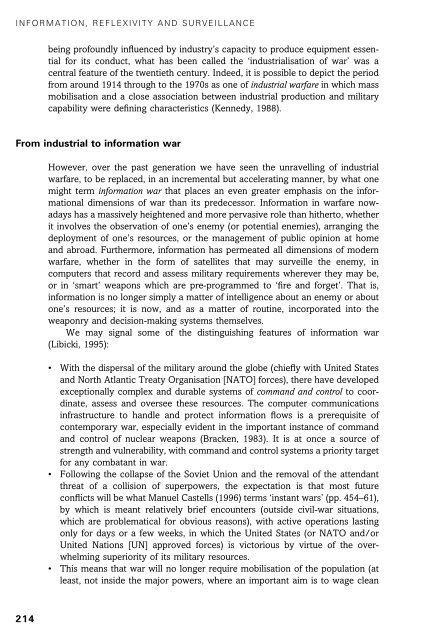Theories of the Information Society, Third Edition - Cryptome
Theories of the Information Society, Third Edition - Cryptome
Theories of the Information Society, Third Edition - Cryptome
Create successful ePaper yourself
Turn your PDF publications into a flip-book with our unique Google optimized e-Paper software.
INFORMATION, REFLEXIVITY AND SURVEILLANCE<br />
being pr<strong>of</strong>oundly influenced by industry’s capacity to produce equipment essential<br />
for its conduct, what has been called <strong>the</strong> ‘industrialisation <strong>of</strong> war’ was a<br />
central feature <strong>of</strong> <strong>the</strong> twentieth century. Indeed, it is possible to depict <strong>the</strong> period<br />
from around 1914 through to <strong>the</strong> 1970s as one <strong>of</strong> industrial warfare in which mass<br />
mobilisation and a close association between industrial production and military<br />
capability were defining characteristics (Kennedy, 1988).<br />
From industrial to information war<br />
However, over <strong>the</strong> past generation we have seen <strong>the</strong> unravelling <strong>of</strong> industrial<br />
warfare, to be replaced, in an incremental but accelerating manner, by what one<br />
might term information war that places an even greater emphasis on <strong>the</strong> informational<br />
dimensions <strong>of</strong> war than its predecessor. <strong>Information</strong> in warfare nowadays<br />
has a massively heightened and more pervasive role than hi<strong>the</strong>rto, whe<strong>the</strong>r<br />
it involves <strong>the</strong> observation <strong>of</strong> one’s enemy (or potential enemies), arranging <strong>the</strong><br />
deployment <strong>of</strong> one’s resources, or <strong>the</strong> management <strong>of</strong> public opinion at home<br />
and abroad. Fur<strong>the</strong>rmore, information has permeated all dimensions <strong>of</strong> modern<br />
warfare, whe<strong>the</strong>r in <strong>the</strong> form <strong>of</strong> satellites that may surveille <strong>the</strong> enemy, in<br />
computers that record and assess military requirements wherever <strong>the</strong>y may be,<br />
or in ‘smart’ weapons which are pre-programmed to ‘fire and forget’. That is,<br />
information is no longer simply a matter <strong>of</strong> intelligence about an enemy or about<br />
one’s resources; it is now, and as a matter <strong>of</strong> routine, incorporated into <strong>the</strong><br />
weaponry and decision-making systems <strong>the</strong>mselves.<br />
We may signal some <strong>of</strong> <strong>the</strong> distinguishing features <strong>of</strong> information war<br />
(Libicki, 1995):<br />
• With <strong>the</strong> dispersal <strong>of</strong> <strong>the</strong> military around <strong>the</strong> globe (chiefly with United States<br />
and North Atlantic Treaty Organisation [NATO] forces), <strong>the</strong>re have developed<br />
exceptionally complex and durable systems <strong>of</strong> command and control to coordinate,<br />
assess and oversee <strong>the</strong>se resources. The computer communications<br />
infrastructure to handle and protect information flows is a prerequisite <strong>of</strong><br />
contemporary war, especially evident in <strong>the</strong> important instance <strong>of</strong> command<br />
and control <strong>of</strong> nuclear weapons (Bracken, 1983). It is at once a source <strong>of</strong><br />
strength and vulnerability, with command and control systems a priority target<br />
for any combatant in war.<br />
• Following <strong>the</strong> collapse <strong>of</strong> <strong>the</strong> Soviet Union and <strong>the</strong> removal <strong>of</strong> <strong>the</strong> attendant<br />
threat <strong>of</strong> a collision <strong>of</strong> superpowers, <strong>the</strong> expectation is that most future<br />
conflicts will be what Manuel Castells (1996) terms ‘instant wars’ (pp. 454–61),<br />
by which is meant relatively brief encounters (outside civil-war situations,<br />
which are problematical for obvious reasons), with active operations lasting<br />
only for days or a few weeks, in which <strong>the</strong> United States (or NATO and/or<br />
United Nations [UN] approved forces) is victorious by virtue <strong>of</strong> <strong>the</strong> overwhelming<br />
superiority <strong>of</strong> its military resources.<br />
• This means that war will no longer require mobilisation <strong>of</strong> <strong>the</strong> population (at<br />
least, not inside <strong>the</strong> major powers, where an important aim is to wage clean<br />
214
















